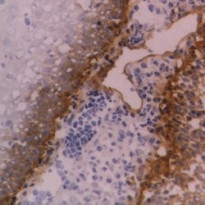ARG23419
anti-CD104 / Integrin beta 4 antibody [450-9D]
anti-CD104 / Integrin beta 4 antibody [450-9D] for Flow cytometry,ICC/IF,IHC-Frozen sections,Immunoprecipitation,Western blot and Human,Ferret
Overview
| Product Description | Mouse Monoclonal antibody [450-9D] recognizes CD104 / Integrin beta 4 Mouse anti Human CD104 antibody, clone 450-9D recognizes the human beta4 integrin, also known as CD104. CD104 is a ~205 kDa glycoprotein which associates with the alpha6 integrin to form the alpha6/beta4 complex. CD104 is expressed on epithelial cells, Schwann cells and various tumor cell lines. Mouse anti Human CD104 antibody, clone 450-9D recognizes an extracellular epitope on the CD104 molecule. |
|---|---|
| Tested Reactivity | Hu, Frt |
| Tested Application | FACS, ICC/IF, IHC-Fr, IP, WB |
| Host | Mouse |
| Clonality | Monoclonal |
| Clone | 450-9D |
| Isotype | IgG1 |
| Target Name | CD104 / Integrin beta 4 |
| Antigen Species | Human |
| Immunogen | Purified alpha6 beta4 integrin from A431 cells. |
| Conjugation | Un-conjugated |
| Alternate Names | Integrin beta-4; GP150; CD antigen CD104; CD104 |
Application Instructions
| Application Suggestion |
|
||||||||||||
|---|---|---|---|---|---|---|---|---|---|---|---|---|---|
| Application Note | IHC-Fr: The epitope recognized by this antibody is reported to be sensitive to formaldehyde fixation and tissue processing. Arigo recommends the use of acetone fixation for frozen sections. FACS: Use 10 µl of the suggested working dilution to label 10^6 cells in 100 µl. * The dilutions indicate recommended starting dilutions and the optimal dilutions or concentrations should be determined by the scientist. |
Properties
| Form | Liquid |
|---|---|
| Purification | Purification with Protein G. |
| Buffer | PBS and 0.09% Sodium azide. |
| Preservative | 0.09% Sodium azide |
| Concentration | 1 mg/ml |
| Storage Instruction | For continuous use, store undiluted antibody at 2-8°C for up to a week. For long-term storage, aliquot and store at -20°C or below. Storage in frost free freezers is not recommended. Avoid repeated freeze/thaw cycles. Suggest spin the vial prior to opening. The antibody solution should be gently mixed before use. |
| Note | For laboratory research only, not for drug, diagnostic or other use. |
Bioinformation
| Database Links | |
|---|---|
| Gene Symbol | ITGB4 |
| Gene Full Name | integrin, beta 4 |
| Background | Integrins are heterodimers comprised of alpha and beta subunits, that are noncovalently associated transmembrane glycoprotein receptors. Different combinations of alpha and beta polypeptides form complexes that vary in their ligand-binding specificities. Integrins mediate cell-matrix or cell-cell adhesion, and transduced signals that regulate gene expression and cell growth. This gene encodes the integrin beta 4 subunit, a receptor for the laminins. This subunit tends to associate with alpha 6 subunit and is likely to play a pivotal role in the biology of invasive carcinoma. Mutations in this gene are associated with epidermolysis bullosa with pyloric atresia. Multiple alternatively spliced transcript variants encoding distinct isoforms have been found for this gene. [provided by RefSeq, Jul 2008] |
| Function | Integrin alpha-6/beta-4 is a receptor for laminin. Plays a critical structural role in the hemidesmosome of epithelial cells. Is required for the regulation of keratinocyte polarity and motility. [UniProt] |
| Calculated MW | 202 kDa |
| PTM | Palmitoylated by DHHC3 at several cysteines of the membrane-proximal region, enhancing stability and cell surface expression. Palmitoylation also promotes secundary association with tertaspanins. [UniProt] |
Images (2) Click the Picture to Zoom In
-
ARG23419 anti-CD104 / Integrin beta 4 antibody [450-9D] IHC-Fr image
Immunohistochemistry: Human tonsil cryostat section stained with ARG23419 anti-CD104 / Integrin beta 4 antibody [450-9D].
-
ARG23419 anti-CD104 / Integrin beta 4 antibody [450-9D] ICC/IF image
Immunofluorescence: Normal human keratinocytes stained with ARG23419 anti-CD104 / Integrin beta 4 antibody [450-9D] (green). Red: Phalloidin.
Clone References









